|
|
Creator | Title | Description | Subject | Date |
| 1 |
 |
Vernon, Kenneth B. | Prearchaic land use in Grass Valley, Nevada: A novel statistical implementation of optimal distribution modeling | Using Prearchaic (PA) sites in Grass Valley, NV (Fig. 1), this project investigates (i) environmental factors driving variation in PA settlement and (ii) geomorphological factors driving variation in PA surface visibility. Building on previous research [1,2], we evaluate variables using Ideal Free D... | Prearchaic - Great Basin; Ideal Free Distribution; Maximum Entropy | 2018 |
| 2 |
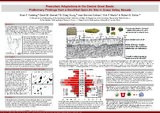 |
Codding, Brian F. | Prearchaic Adaptations in the Central Great Basin: Preliminary findings from a stratified open-air site in Grass Valley, Nevada | Early Holocene occupants of the Great Basin preferentially occupied highly productive habitats surrounding pluvial lakes. While growing evidence details in the adaptations of these Prearchaic foragers in the Eastern (e.g., Madsen et al. 2015) and Western Great Basin (e.g., Jenkins et al. 2012), our... | Anthropology, Cultural - methods - United States; Anthropology, Cultural - methods - Great Basin; Anthropology - Grass Valley, Nevada | 2016 |
| 3 |
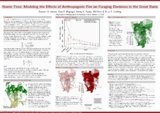 |
Vernon, Kenneth B. | Numic fires: modeling the effects of anthropogenic fire on foraging decisions in the Great Basin | Across Western North America, hunter-gatherers modified their surrounding environment with the application of fire (1; 11; 15). However, to date we lack a general theoretical framework to investigate the reasons why people would burn or its effects on traditional foraging economies. To begin to fill... | Behavioral ecology; Diet; Fire | 2015 |
| 4 |
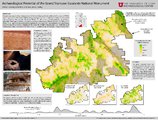 |
Yaworsky, Peter M. | Archaeological Potential of the Grand Staircase-Escalante National Monument | Executive proclamation 9682 reduces the size of the Grand Staircase-Escalante National Monument (GSENM), removing protections for at least 2,000 known archaeological sites and an unknown number of undiscovered cultural properties. Because only 10% of the GSENM's 1.9 million acres has been inventorie... | Grand Staircase-Escalante National Monument; Anthropology-Research | 2018 |
| 5 |
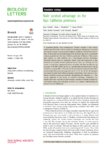 |
Macfarlan, Shane | Male Survival Advantage on the Baja California Peninsula | A consistent finding from contemporary Western societies is that women outlive men. However, what is unclear is whether sex differences in survival are constant across varying socio-ecological conditions. We test the universality of the female survival advantage with mortality data from a nineteenth... | ecology; health and disease and epidemiology; behaviour | 2020 |
| 6 |
 |
O'Connell, James F. | A Different Paradigm for the Initial Colonisation of Sahul: Archaeological, genetic, demographic and geographic perspectives | The questions of when and how humans reached Sahul, the Pleistocene continent of Australia and New Guinea, has remained a central issue of Australian archaeology since its development as an academic discipline in the mid-twentieth century. Additionally, this has been a dominant theme linking Austral... | Sahul; Wallacea; colonisation; isolation; genomics; mitochondrial DNA | 2019-08-20 |
| 7 |
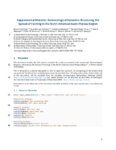 |
Codding, Brian F. | Supplementary Materials: Socioecological dynamics structuring the spread of farming in the North American Basin-Plateau Region | This document includes the code used to complete the analysis presented in the manuscript "Socioecological Dynamics Structuring the Spread of Farming in the North American Basin-Plateau Region" in Environmental 15 Archaeology. | environmental archaeology | |
| 8 |
 |
Codding, Brian F. | Socioecological dynamics structuring the spread of farming in the North American Basin-Plateau Region | The spread of agriculture is a major driver of social and environmental change throughout 25 the Holocene, yet experimental and ethnographic data indicate that farming is less profitable than foraging, so why would individuals choose to adopt agriculture leading to its expansion? Ideal distribution ... | Ideal free distribution model; population ecology; behavioral ecology; maize agriculture; Ancestral Puebloan; Fremont Complex | 2021 |
| 9 |
 |
Codding, Brian F. | External impacts on internal dynamics: Effects of paleoclimatic and demographic variability on acorn exploitation along the Central California coast | Research into human-environment interaction in California prehistory often focuses on either the internal dynamics of adaptive decisions or the external impacts of environmental change. While both processes were surely driving prehistoric variability, integrating these approaches is not altogether s... | Acorn exploitation; Prehistoric land use; Behavioral ecology | 2016 |
| 10 |
 |
Hawkes, Kristen | Hadza scavenging: implications for Plio/Pleistocene Hominid subsistence | The frequent association of stone tools and large animal bones in African Plio/Pleistocene archaeological sites has long been taken as evidence of the importance of hunting in early hominid diets. Many now argue that it reflects hominid scavenging, not hunting. | Hadza; Scavenging; Plio/Pleistocene; Hominid Diet | 1988-04 |
| 11 |
 |
Hawkes, Kristen | Hadza women's time allocation, offspring provisioning, and the evolution of long postmenopausal life spans | Extended provisioning of offspring and long postmenopausal life spans are characteristic of all modern humans but no other primates. These traits may have evolved in tandem. Analysis of relationships between women's time allocation and children's nutritional welfare among the Hadza of northern Tanza... | Child care; Children, nutrition; Life spans, Biology; Mother & child; Primates; Social structure; Women; Time Management; Hominids | 1997 |
| 12 |
 |
Hawkes, Kristen | Hadza children's foraging: juvenile dependency, social arrangement and mobility among hunter-gatherers | Presents a study on the foraging activities of Hadza children in Tanzania, Africa. Success of children's foraging; Determinants of children's foraging; Monitoring of the activities of children; Near-camp foraging return rates; Variables underlying the patterns of foraging. | Children; Foraging; Hazda; Hunter-gatherers | 1995 |
| 13 |
 |
Cashdan, Elizabeth A. | Technological change and child behavior among the !Kung | How does change in one part of a social system affect other parts? This is the central question that must be answered in order to understand the process through which culture changes. This paper is about a small piece of the problem. It investigates how changes in subsistence economy affect child be... | Child behavior; Technological change; Foraging groups; Settled groups | 1988 |
| 14 |
 |
Cashdan, Elizabeth A. | Competition between foragers and food producers on the Botletli River, Botswana | The immigration of food-producing groups into areas occupied by hunters and gatherers must have been a common occurrence in prehistory. How were the hunter-gatherers affected by this? I describe here two groups of Kalahari Basarwa ('Bushmen'), one living along the flood plain of the lower Botletli ... | Kalahari Basarwa; Bushmen; Foraging; Cattle | 1986 |
| 15 |
 |
Broughton, John | Terminal Pleistocene fish remains from Homestead Cave, Utah, and implications for fish biogeography in the Bonneville Basin | Eleven fish species were identified from Homestead Cave, Utah. The remains, concentrated in the lowest stratum of the deposit, were accumulated by owls between approximately 11,200 and 10,100 14C yr B.P. and likely represent fish associated with the final die-off of the Lake Bonneville fauna. Fou... | Fish assemblage; Quaternary; Lake Bonneville | 2000 |
| 16 |
 |
McCullough, John M. | Relatedness and kin-structured migration in a founding population: Plymouth colony, 1620-1633 | To test the common assumption of no genetic relationship in a founding population, we calculated average relatedness (r) for the emigrants to Plymouth Colony from Europe on seven voyages from 1620 to 1633. Of 355 individuals, 255 could be individually identified and 4 generations of genealogic depth... | | 1991 |
| 17 |
 |
Broughton, John | Size of the bursa of fabricius in relation to gonad size and age in laysan and black-footed albatrosses | Age determination can be difficult for birds that undergo little or no plumage change during life. This is the case for Laysan and Black-footed Albatrosses (Diomedea immutabilis and D. nigripes). The juvenile plumage for both these North Pacific albatrosses is completely grown by about five to six m... | Birds; Species; Development | 1994 |
| 18 |
 |
McCullough, John M. | Evidence for assortative mating and selection in surnames: a case from Yucatan, Mexico | Surnames are often used as metaphors for genetic material on the assumption of neutrality and general immunity from systematic pressures. The Yucatec Maya use surnames of both Maya and Spanish origin. We find evidence of positive assortative mating by ethnic origin of surname and a slight bias away ... | Surnames; Assortative mating; Maya | 1985 |
| 19 |
 |
Hawkes, Kristen | Why hunter-gatherers work: An ancient version of the problem of public goods | From the abstract: People who hunt and gather for a living share some resources more widely than others. A favored hypothesis to explain the differential sharing is that giving up portions of large, unpredictable resources obligates others to return shares of them later, reducing everyone's variance... | Hunter-gatherer societies; Public goods | 2001-08 |
| 20 |
 |
O'Rourke, Dennis H. | Refutation of the general single locus model for the etiology of schizophrenia | All published studies on the familial incidence of schizophrenia appropriate for testing the applicability of the general single-locus two-allele model are examined under the assumption of a unitary etiology for all schizophrenia. We show that the single major locus model is inadequate to predict th... | Genetics; Diseases in Twins; Chromosome Mapping | 1982 |
| 21 |
 |
Rogers, Alan R. | Migration and genetic drift in human populations | In humans and many other species, mortality is concentrated early in the life cycle, and is low during the ages of dispersal and reproduction. Yet precisely the opposite is assumed by classical population-genetics models of migration and genetic drift. We introduce a model in which population regul... | Frequencies; Variance; Dynamics | 1986 |
| 22 |
 |
O'Rourke, Dennis H. | Spatial and temporal stability of mtDNA haplogroup frequencies in native North America | Mitochondrial DNA lineage frequencies in prehistoric Aleut, eastern Utah Fremont, Southwestern Anasazi, Pyramid Lake, and Stillwater Marsh skeletal samples from northwest Nevada and the Oneota of western Illinois are compared with those in 41 contemporary aboriginal populations of North America. T... | Mitochondrial DNA; Lineage variation; Haplogroup assignment | 2000 |
| 23 |
 |
Rogers, Alan R. | Model of kin-structured migration | When individuals disperse from one local group to another, they often do so in the company of relatives. This is known as "kin-structured migration," and its effect on genetic population structure is investigated here. It is shown that when migration is kin-structured, the ratio of between- to with... | Fission; Mobility; Population | 1987 |
| 24 |
 |
Wiessner, Pauline W. | Wealth transmission and inequality among hunter-gatherers | We report quantitative estimates of intergenerational transmission and population-wide inequality for wealth measures in a set of hunter-gatherer populations. Wealth is defined broadly as factors that contribute to individual or household well-being, ranging from embodied forms, such as weight and h... | | 2010-02 |
| 25 |
 |
Rogers, Alan R. | Doubts about isonymy | The method of isonymy, developed by Crow and Mange for estimating inbreeding from surname frequencies, requires an assumption that has not been appreciated: It is necessary to assume that all males in some ancestral generation, the founding stock, had unique surnames. Because this assumption is sel... | | 1991 |

























